Abstract
Glucocorticoid levels in animals may respond to and influence the development of social attachments. This hypothesis was tested in prairie voles (Microtus ochrogaster), monogamous rodents that form long-term heterosexual pair bonds. In socially naive female prairie voles, cohabitation with an unfamiliar male resulted in a dramatic decline in serum corticosterone levels. When corticosterone levels were reduced via adrenalectomy, females developed partner preferences after 1 h of cohabitation, while sham-operated and untreated females required 3 h or more of nonsexual cohabitation to establish a partner preference. In adrenalectomized and intact females, exogenous injections of corticosterone, given prior to social exposure, prevented the development of preferences for the cohabitating male. Although corticosterone inhibited the development of partner preferences, it did not interfere with the expression of previously established social preferences. These results suggest that social stimuli can modulate adrenal activity and that adrenal activity, in turn, is capable of influencing the formation of adult social preferences in female prairie voles. The involvement of the adrenal axis in the formation of partner preferences and the subsequent development of pair bonds provides a mechanism through which environmental and social factors may influence social organization in this species.
Full text
PDF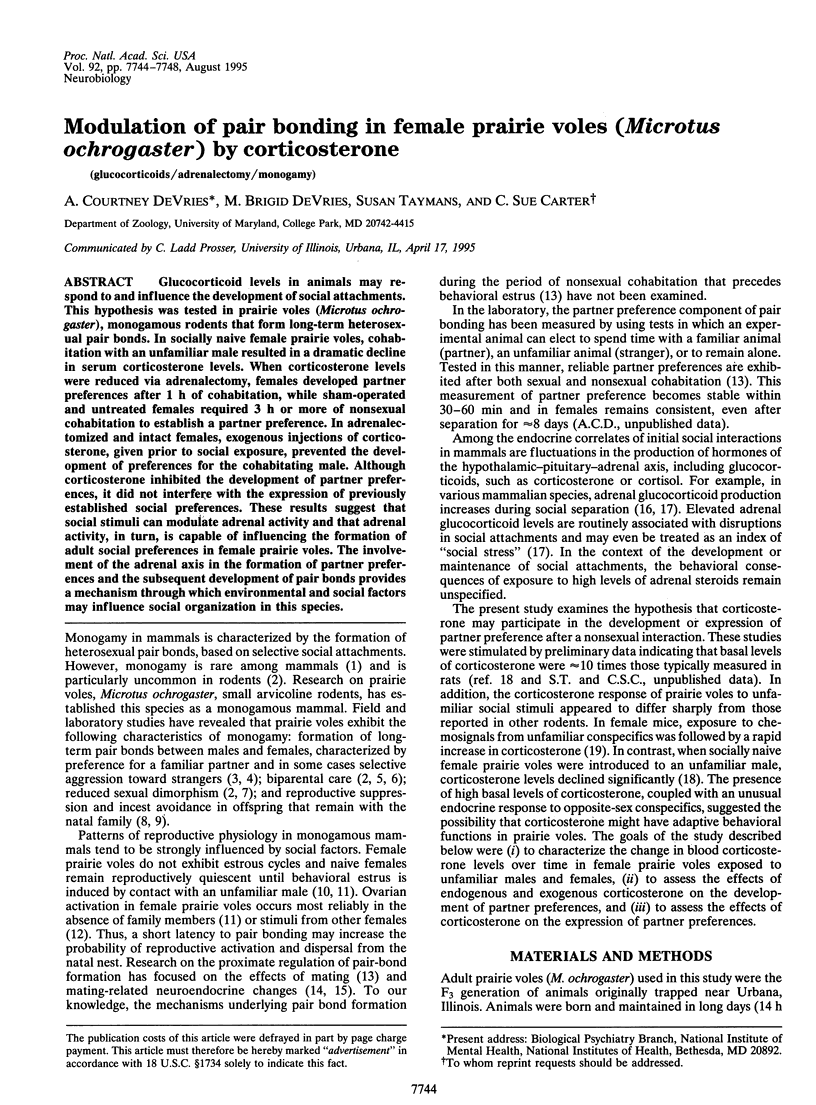
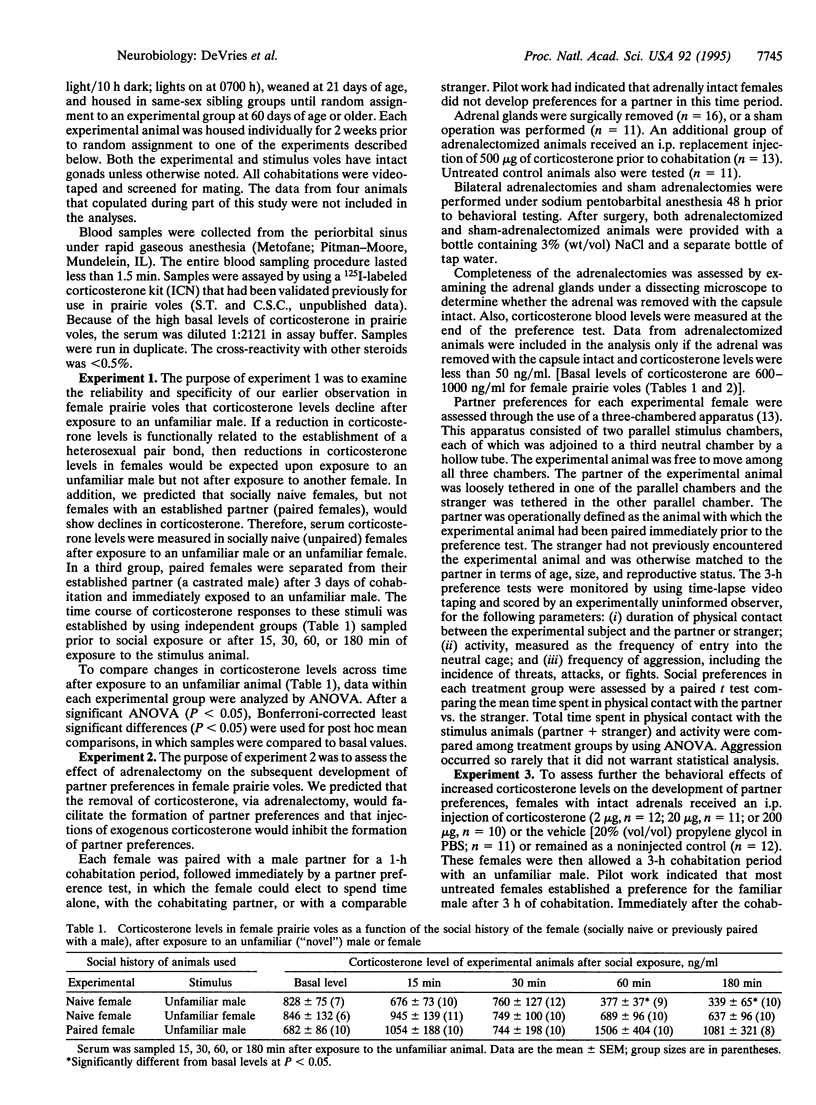
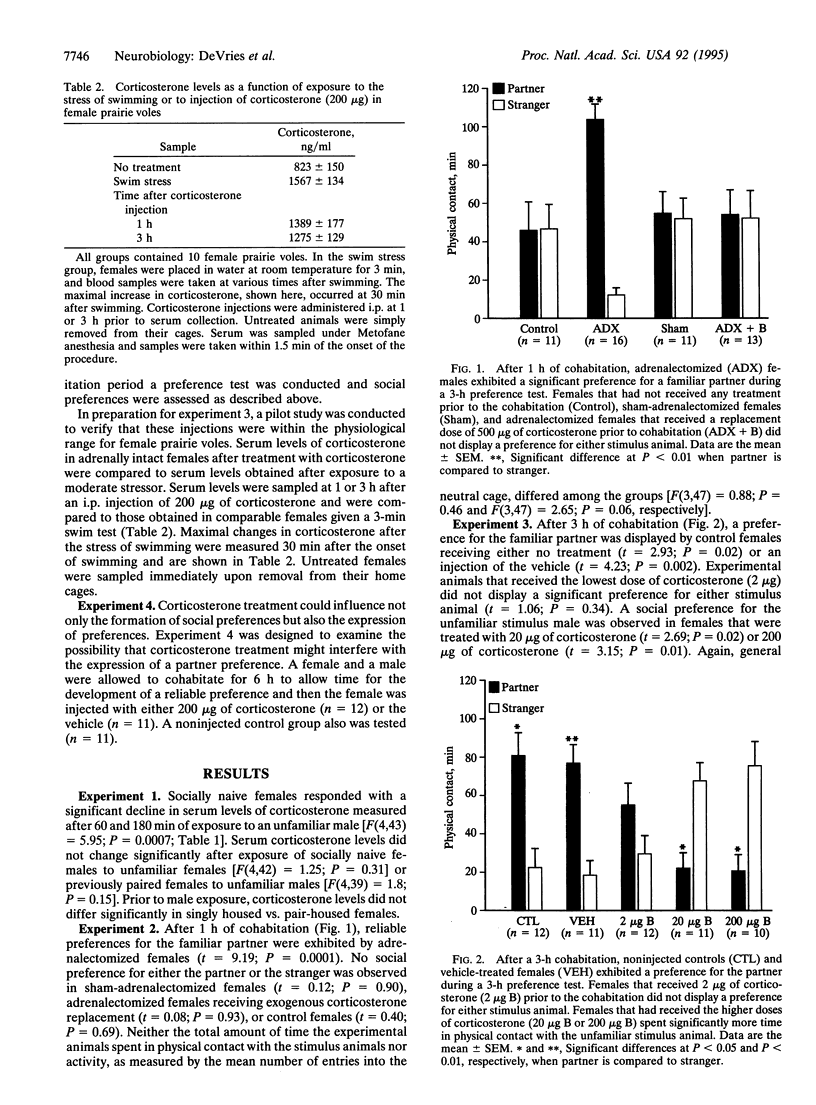
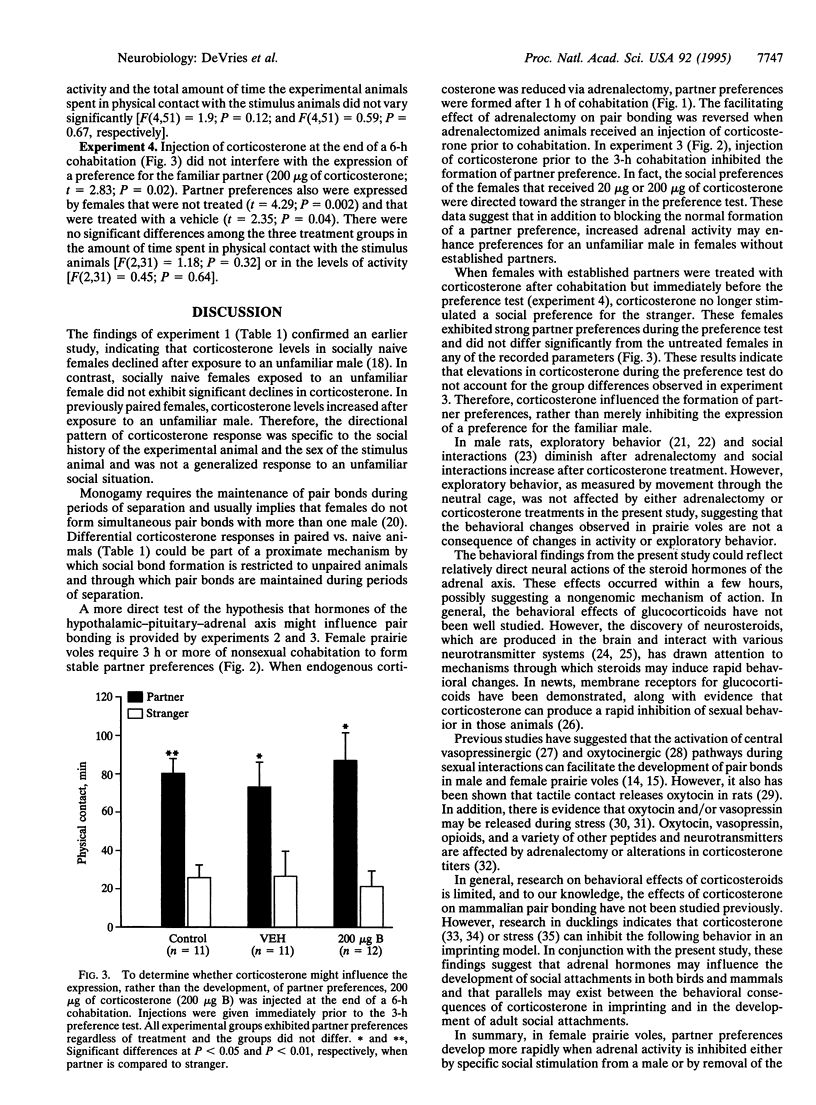
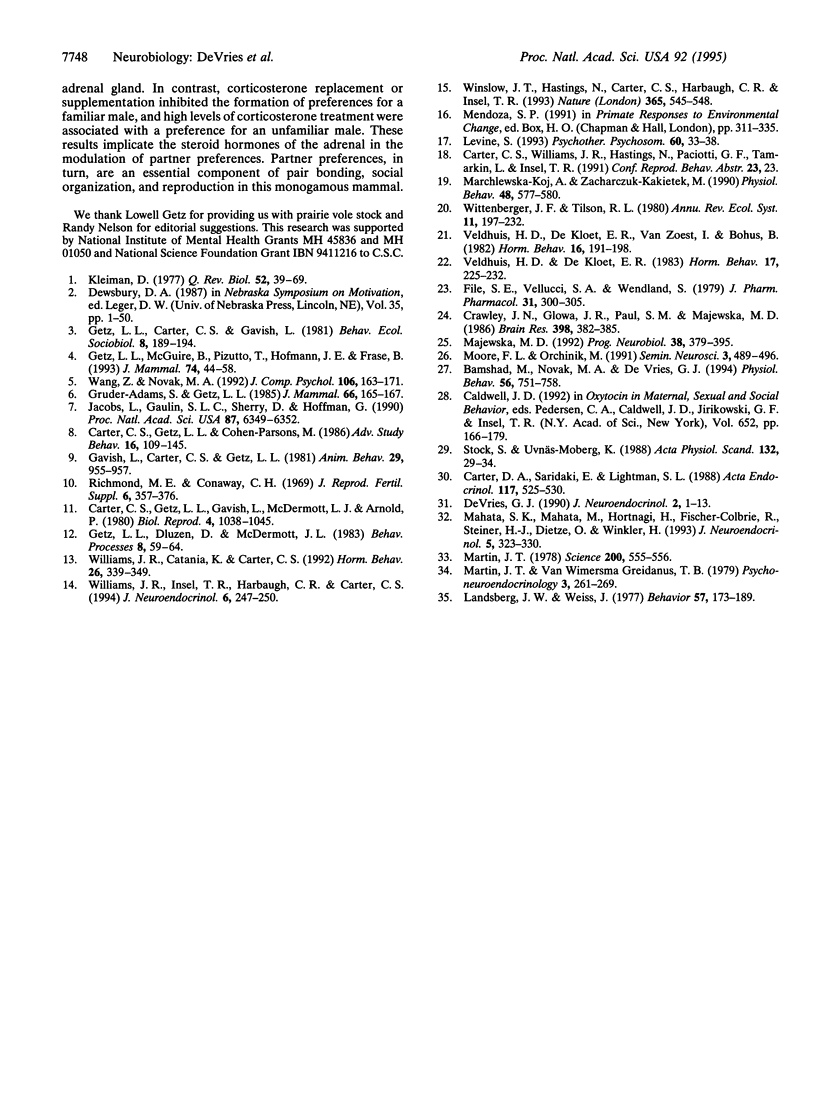
Selected References
These references are in PubMed. This may not be the complete list of references from this article.
- Bamshad M., Novak M. A., de Vries G. J. Cohabitation alters vasopressin innervation and paternal behavior in prairie voles (Microtus ochrogaster). Physiol Behav. 1994 Oct;56(4):751–758. doi: 10.1016/0031-9384(94)90238-0. [DOI] [PubMed] [Google Scholar]
- Carter C. S., Getz L. L., Gavish L., McDermott J. L., Arnold P. Male-related pheromones and the activation of female reproduction in the prairie vole (Microtus ochrogaster). Biol Reprod. 1980 Dec;23(5):1038–1045. doi: 10.1095/biolreprod23.5.1038. [DOI] [PubMed] [Google Scholar]
- Carter D. A., Saridaki E., Lightman S. L. Sexual differentiation of oxytocin stress responsiveness: effect of neonatal androgenization, castration and a luteinizing hormone-releasing hormone antagonist. Acta Endocrinol (Copenh) 1988 Apr;117(4):525–530. doi: 10.1530/acta.0.1170525. [DOI] [PubMed] [Google Scholar]
- Crawley J. N., Glowa J. R., Majewska M. D., Paul S. M. Anxiolytic activity of an endogenous adrenal steroid. Brain Res. 1986 Nov 29;398(2):382–385. doi: 10.1016/0006-8993(86)91500-3. [DOI] [PubMed] [Google Scholar]
- File S. E., Vellucci S. V., Wendlandt S. Corticosterone -- an anxiogenic or an anxiolytic agent? J Pharm Pharmacol. 1979 May;31(5):300–305. doi: 10.1111/j.2042-7158.1979.tb13505.x. [DOI] [PubMed] [Google Scholar]
- Jacobs L. F., Gaulin S. J., Sherry D. F., Hoffman G. E. Evolution of spatial cognition: sex-specific patterns of spatial behavior predict hippocampal size. Proc Natl Acad Sci U S A. 1990 Aug;87(16):6349–6352. doi: 10.1073/pnas.87.16.6349. [DOI] [PMC free article] [PubMed] [Google Scholar]
- Kleiman D. G. Monogamy in mammals. Q Rev Biol. 1977 Mar;52(1):39–69. doi: 10.1086/409721. [DOI] [PubMed] [Google Scholar]
- Landsberg J. W., Weiss J. Stress and increase of the corticosterone level prevent imprinting in ducklings. Behaviour. 1976;57(3-4):173–189. doi: 10.1163/156853976x00505. [DOI] [PubMed] [Google Scholar]
- Levine S. The influence of social factors on the response to stress. Psychother Psychosom. 1993;60(1):33–38. doi: 10.1159/000288677. [DOI] [PubMed] [Google Scholar]
- Mahata S. K., Mahata M., Hörtnag H., Fischer-Colbrie R., Steiner H. J., Dietze O., Winkler H. Concomitant changes of messenger ribonucleic acid levels of secretogranin II, VGF, vasopressin and oxytocin in the paraventricular nucleus of rats after adrenalectomy and during lactation. J Neuroendocrinol. 1993 Jun;5(3):323–330. doi: 10.1111/j.1365-2826.1993.tb00489.x. [DOI] [PubMed] [Google Scholar]
- Majewska M. D. Neurosteroids: endogenous bimodal modulators of the GABAA receptor. Mechanism of action and physiological significance. Prog Neurobiol. 1992;38(4):379–395. doi: 10.1016/0301-0082(92)90025-a. [DOI] [PubMed] [Google Scholar]
- Marchlewska-Koj A., Zacharczuk-Kakietek M. Acute increase in plasma corticosterone level in female mice evoked by pheromones. Physiol Behav. 1990 Nov;48(5):577–580. doi: 10.1016/0031-9384(90)90194-9. [DOI] [PubMed] [Google Scholar]
- Martin J. T., van Wimersma Greidanus T. B. Imprinting behavior: influence of vasopressin and ACTH analogues. Psychoneuroendocrinology. 1978 Oct;3(3-4):261–269. doi: 10.1016/0306-4530(78)90017-3. [DOI] [PubMed] [Google Scholar]
- Stock S., Uvnäs-Moberg K. Increased plasma levels of oxytocin in response to afferent electrical stimulation of the sciatic and vagal nerves and in response to touch and pinch in anaesthetized rats. Acta Physiol Scand. 1988 Jan;132(1):29–34. doi: 10.1111/j.1748-1716.1988.tb08294.x. [DOI] [PubMed] [Google Scholar]
- Veldhuis H. D., De Kloet E. R. Antagonistic effects of aldosterone on corticosterone-mediated changes in exploratory behavior of adrenalectomized rats. Horm Behav. 1983 Jun;17(2):225–232. doi: 10.1016/0018-506x(83)90009-0. [DOI] [PubMed] [Google Scholar]
- Veldhuis H. D., De Kloet E. R., Van Zoest I., Bohus B. Adrenalectomy reduces exploratory activity in the rat: a specific role of corticosterone. Horm Behav. 1982 Jun;16(2):191–198. doi: 10.1016/0018-506x(82)90018-6. [DOI] [PubMed] [Google Scholar]
- Williams J. R., Catania K. C., Carter C. S. Development of partner preferences in female prairie voles (Microtus ochrogaster): the role of social and sexual experience. Horm Behav. 1992 Sep;26(3):339–349. doi: 10.1016/0018-506x(92)90004-f. [DOI] [PubMed] [Google Scholar]
- Williams J. R., Insel T. R., Harbaugh C. R., Carter C. S. Oxytocin administered centrally facilitates formation of a partner preference in female prairie voles (Microtus ochrogaster). J Neuroendocrinol. 1994 Jun;6(3):247–250. doi: 10.1111/j.1365-2826.1994.tb00579.x. [DOI] [PubMed] [Google Scholar]
- Winslow J. T., Hastings N., Carter C. S., Harbaugh C. R., Insel T. R. A role for central vasopressin in pair bonding in monogamous prairie voles. Nature. 1993 Oct 7;365(6446):545–548. doi: 10.1038/365545a0. [DOI] [PubMed] [Google Scholar]


